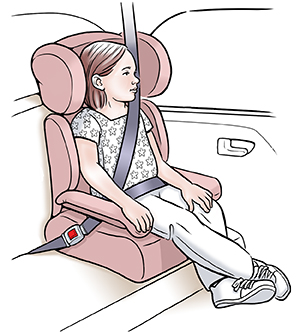Upgrading to booster seats
Using the right safety car seat can often prevent injuries to children during car accidents. As children grow, the type of car seat they need will change. The American Academy of Pediatrics (AAP) and the National Highway Traffic Safety Administration have guidelines to help you find the right car seat for your child. Also, look at the owner’s manual of your car seat or the one you're thinking about buying.
Follow this advice:
|
Birth to age 1 |
Always use a rear-facing car seat in the back seat. |
|
Ages 1 to 3 |
Babies and toddlers should ride in a rear-facing car seat for as long as possible. That means until they reach the top weight or height allowed by their seat. Check the seat's instructions for these limits. Most convertible car seats have height and weight limits that will allow children to ride rear-facing for at least 2 years. |
|
Ages 4 to 7 |
Use a forward-facing car seat with a harness and tether until children reach the top height or weight limit allowed by the maker of the car seat. (Check the instructions for this information.) When your child outgrows the forward-facing car seat with a harness, switch to a booster seat. This booster seat should stay in the back seat. |
|
Ages 8 to 12 |
Use a booster seat until your child is big enough to fit in a seat belt the right way. For a seat belt to fit well, the lap belt must be snug across the upper thighs, not the stomach. The shoulder belt should lie snugly across the shoulder and chest. It shouldn't cross the neck or face. Remember: Your child should still ride in the back seat because it’s safer. |
To use a booster seat safely
Children who are taller or weigh more than the limit for a forward-facing car seat should switch to a belt-positioning booster seat, according to the AAP. It's important to check your car seat owner’s manual for the seat's height and weight limits. Booster seats raise a child up so the car’s seat belt fits the right way. There are two types of booster seats. One type has a back. The other doesn't have a back. To use either type of booster seat safely:
-
Use the lap belt and shoulder belt every time your child rides in the booster seat. Never put the shoulder belt under the child’s arm or behind their back. This can lead to severe internal injury during a car accident.
-
Never use a booster seat if only a lap belt is available.
-
Check that your child uses a booster seat even when riding in someone else’s vehicle. Have every person who drives your child use the correct booster seat or car seat belt. This needs to be done for every trip, every time. Being consistent is safest for children and reduces their complaints.
-
If the vehicle’s seat has no headrest, use a booster seat that has a high back.
-
Let your child help choose their booster seat. This can help make them more willing to use it.
Teaching your child to be safe
As your child gets older and rides in cars with other drivers, it's even more important for them to understand car safety rules. To help keep your child safe:
-
Explain to your child that a booster seat will help keep them safe in a car crash.
-
Check that your child understands that they must use a booster seat in every vehicle, every time. No exceptions.
-
Have older children help set an example for younger kids by buckling up.
-
Don’t forget that your child learns by watching adults. So use your seat belt every trip, every time, no matter the driving distance.
-
Never let passengers share a seat belt. Each passenger must have their own age- and weight-appropriate safety car seat or seat belt.
-
All seat belts should be buckled before the car moves.
-
Never give in to a child's request to sit in the front seat before it's safe or to ride unbuckled, even for a very short distance.
Featured in


